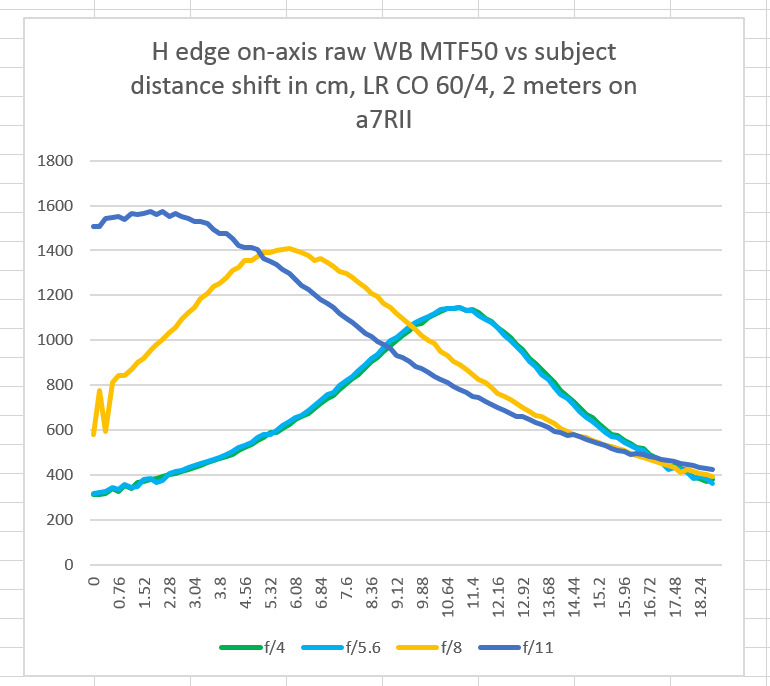This is a continuation of testing of the following macro lenses :
- Sony 90mm f/2.8 FE Macro
- Leica 100mm f/2.8 Apo Macro-Elmarit-R
- Zeiss 100mm f/2 Makro-Planar ZF
- Nikon 105mm f/2.8 Micro-Nikkor G VR
- Coastal Optical 60mm f/4 UV-VIS-IR
Earlier I reported on more focus shift that seemed right in the Coastal 60mm f/4 Macro lens:
I got a copy of the CO 60/4 from LensRentals yesterday to see if it measured differently than my copy.
The answer?
Not by much.
The LoCA curves are excellent, and I won’t bore you with them.
Here’s the white balanced focus shift curve:
You’ll note that the f/4 and the f/5.6 curves are right on top of each other. The exposure was the same for those to runs, too. It looks like the diaphragm blades aren’t moving much between those settings. My very own CO 60 only shows a third stop drop in light when you move the aperture ring from f/4 to f/5.6, and the focus shift curves for those two stops were very close.
It’s now looking like either the focus shift is designed into the lens (based on a sample space of two, which isn’t really enough for any kind of certainty), or there is a systematic manufacturing problem.
By the way, I find it odd that the f/11 numbers are better than the f/8 numbers, and I put this down to the lens really being at f/8 when it’s set at f/11 and f/5.6 when it’s set at f/8. I also think my labled aperture values in the curves for the CO lens that I previously presented were off for the same reason, just not as far.
Measuring the entrance pupils with dial calipers — thanks Frans! — yields this:
That should be pretty self explanatory, but just in case it isn’t, the first column is the indicated f/stop. The next two are my (necessarily imprecise, considering my method) entrance pupil measurements in inches, the next two convert those to mm, and the last two are the calculated f-stops assuming the focal length is 60mm.
Those numbers jibe with the exposure meter readings.
Kinda weird. At least it doesn’t appear that I have a bad copy of the lens.


I’m curious what the application[s] you have for the Coastal f/4. Macro? Repro-graphics?
Is it an option to return the Coastal, or been too long, or it’s still worth owning, and you know its character to avoid issues?
My application is infrared photography. It turns out to be a good copy; at least better than the LR copy. I’ll post new curves tomorrow. Sorry this is short. I’m in a rush.
Jim
Jim, interesting measurement of the f-number, I’ve never checked that before. May I ask exactly what it is that you measured with the calipers? Should one check the entrance or the exit pupil? I would have guessed the latter.
Jack
I measured the apparent size of the entrance pupil, as seen with my eye at .75 meters from the lens, and the calipers as near to the front element as I could safely place them.
Jim